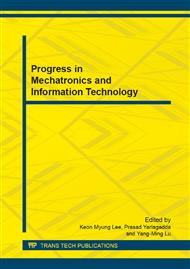[1]
You Fucheng, Zhang Lifan, and Zhang Yongbin: The Research of Printing's Image Defect Inspection Based on Machine Vision, in Proc. ICMA, 2009, pp.2404-2408.
DOI: 10.1109/icma.2009.5246130
Google Scholar
[2]
Xie Xianghua,: A Review of Recent Advances in Surface Defect Detection using Texture analysis Technique, Electronic Letters on Computer Vision and Image Analysis, vol. 7, no. 3, pp.1-22, (2008).
DOI: 10.5565/rev/elcvia.268
Google Scholar
[3]
Ajay Kumar: Computer-Vision-Based Fabric Defect Detection: A Survey, IEEE TRANSCATIONS ON INDUSTRIAL ELECTRONIC, vol. 55, no. 1, pp.348-363, (2008).
DOI: 10.1109/tie.1930.896476
Google Scholar
[4]
Zhi Cijia: Automation Detection System of the Printed Matter Defects Based on the Machine Vision Technology, Guangdong University of Technology, May (2011).
Google Scholar
[5]
R.J. Ong, J.T. Dawley and P.G. Clem: submitted to Journal of Materials Research (2003).
Google Scholar
[5]
Lorenzo Bruzzone, Diego Fernandez prieto: Automatic Analysis of the Difference Image for Unsupervised Change Detection, IEEE TRANSACTION ON GEOSCIENCE REMOTE SENSING, vol. 38, no. 3, pp.1171-1182, (2000).
DOI: 10.1109/36.843009
Google Scholar
[6]
C. Wren, A. Azarbayejani, T. Darrell, and A. Pentland: Pfinder: Real-time tracking of the human body, In IEEE Trans. PAMI, (1997).
DOI: 10.1109/34.598236
Google Scholar
[7]
C. Stauffer, W. E. L. Grimson: Adaptive Background Mixture Models for Real-Time Tracking, in IEEE proc. CVPR, vol. 2, pp.246-252, (1999).
Google Scholar
[8]
Marko Heikkila, Matti Pietikainen: A Texture-Based Method for Modeling the Background and Detecting Moving Objects, In IEEE Trans, PAMI, vol. 28, no. 4, (2006).
DOI: 10.1109/tpami.2006.68
Google Scholar
[9]
T. Bouwmans: Subspace Learning for Background Modeling: A Survey, Recent Patent On Computer Science, vol. 2, no. 3, pp.223-234, (2009).
DOI: 10.2174/2213275910902030223
Google Scholar
[10]
Massimo Piccardi: Background subtraction techniques: a review, IEEE International Conference on Systems, pp.3099-3104, (2004).
Google Scholar
[11]
A. Elgammal, D. Harwood, and L. Davis: Non-parametric model for background subtraction, in ECCV, (2000).
Google Scholar
[12]
Sebastian Brutzer, Benjamin Hoferlin and Gunther Heidemann: Evaluation of Background Subtraction Techniques for Video Surveillance, in Proc. CVPR, 2011, p.1937-(1944).
DOI: 10.1109/cvpr.2011.5995508
Google Scholar
[13]
Briechle, Kai, and Uwe D. Hanebeck. Template matching using fast normalized cross correlation. Aerospace/Defense Sensing, Simulation, and Controls. International Society for Optics and Photonics, (2001).
Google Scholar


